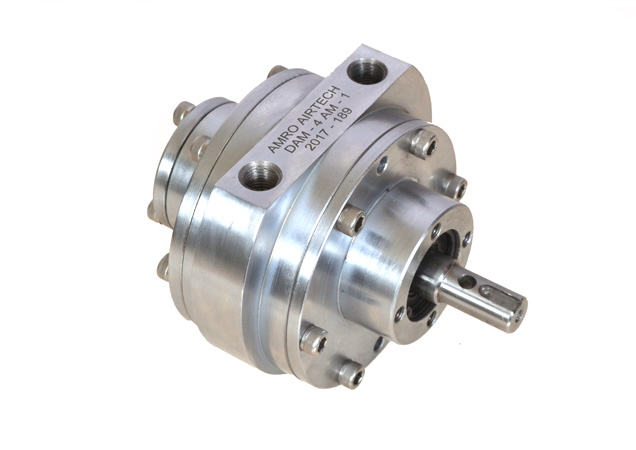- Call Us On
+91 9890135193
- Mail Us On

| KW | 1.25 |
| HP | 1.7 |
| Free Speed RPM | 5000 |
| Operating Speed RPM | 3000 |
| Stall Torque Nt-Mt | 6 |
| Operating Torque Nt-Mt | 4 |
| Rotation | Reversible |
| Air Inlet Port BSP | 1/4" |
| Air Outlet Port BSP | 1/4" |
| Mounting | Flange |
| Air Pressure Max Kg/cm2 | 6 |
| Air Consumption M3/min | 2.3 |
| Air Hose Size mm | 10 x 12 |
| Air House Length mtrs | 3 |
| Weight kg | 4.5 |



Operating Instructions
- Connect the air motor to the air line by a proper connection. The air inlet threads are ¼" BSP. The air hose size should be minimum 10 mm ID and the length of the air hose should be 3 meters maximum. There should be no water in the air line.
- If speed is to be varied, an inline airline regulator should be provided near the air inlet port of the air motor.
- If the air motor is to be operated by solenoid or manual direction control valves, the valves should be of ½" size. The valves should not be more than 3 meters from the air motor.
- For non-reversible use, a silencer should be connected to the exhaust port of the air motor. Various types of silencers are available. Too much silencing will affect the speed and torque of the air motor. Proper selection of the silencer is important for balancing the sound level and the speed/torque.
- The optimum air pressure for operation is 4 kg/cm2. Maximum air pressure should not exceed 6 kg/cm2.
- Lubrication is important for the air motor. An inline air lubricator should be fitted. If that is not possible, the lubricating oil (10 ml) should be put inside the air motor through the air inlet after every 4 hours of operation.
- If the air motor is going to remain idle for a long period of several days, it should be lubricated with oil and both the ports should be plugged.
- Do not hammer the output shaft of the air motor with hammer while putting a coupling on it. The coupling should slide easily on the shaft.
Maintenance Instructions
- Use a hand press for removing the front plate and the rear plate from the housing of the air motor. Do not hammer the rotor.
- Use hand press for assembly of ball bearings into front and rear plates.
- Fully tighten all the screws on assembly before starting the motor.
- The rotor should be adjusted inside the housing by gently hammering the centre holes on both sides by a centre punch. The rotor should be free to rotate by using a spanner in hand.
- Proper and timely lubrication is a must for trouble free performance.
- Use genuine AMRO spare parts.
Trouble Shooting and On Site Problem Solving
If the motor starts running at less speed or loses it torque during running, the silencer may have got clogged. Remove the silencer and run the motor. If it runs properly, replace the silencer.
If the motor gets the air supply through several valves or through a solenoid valve or a manual valve, and if it is not running to the expected speed or torque, check the number of valves and the size of the valves. The port size of the valves should be ½"or above. The number of valves should be minimum.
It is often observed that the air compressor is at a long distance from the air motor. If the pressure gauge on the distant air compressor shows a reading of 4 kg/cm2, it does not necessarily mean that the air pressure at the air motor inlet is 4 kg/cm2. The air pressure gets dropped down due to several reasons such as length of the air hose, size of the air hose, bends and different joints in the air hose and the size of the valves in the airhose.
If the air motor is jammed, tap the top of the rotor lightely by a plastic or aluminium hammer. Try to rotate the rotor by a spanner by hand. Do not apply excessive force. If it is still jammed, remove the back cover and punch the rotor by a centre punch. Do not use excessive force. Try to rotate the rotor by a spanner by hand. If it is free, connect the motor to the air line. If the rotor is still jammed, you may have to send it to the AMRO factory.
For dismantling the air motor, use hand press for removing the rotor shaft. Use proper tools and jigs and fixtures. Do not hammer to rotor shaft, otherwise it may get flared. It is advisable to replace the gaskets, ball bearings and the oil seal. While replacing the old rotor blades with new ones, adjust the size of each blade with its slot by rubbing it on a sand paper. The blade should not come out of the slot from any side.



